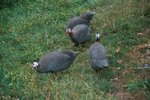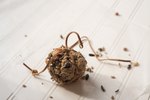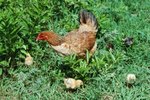
It's easy to see that hummingbirds have high energy requirements, with all the darting around they do. Hummingbirds feed up to eight times an hour, eating up to 10 times their body weight in food every day. Nectar helps them meet their energy needs, and insects provide protein, vitamins, minerals and amino acids.
Homemade Nectar
Homemade hummingbird nectar is simple to prepare; you need 4 parts water to 1 part granulated cane sugar. Bring the water to a boil and remove it from heat, then stir in the cane sugar until it's dissolved. After the liquid is cool, add it to your feeder. If you want to prepare larger batches, this homemade hummingbird nectar will keep in the refrigerator for up to two weeks.
Just Sugar, Please
Though you may be tempted to go "natural" or "lite" for your visitors, stick with white granulated sugar. Never use artificial sweeteners, flavorings, honey, molasses, brown sugar or jello. Although red food coloring is pretty in the nectar, it's not necessary to draw hummingbirds to a feeder. If you want more color around your feeder, tie a pretty ribbon around the top of the feeder.
Change Is Good
Sugar water can spoil quickly in the feeder, and mold and bacteria will grow if hummingbirds don't suck it up readily. Change your nectar regularly for a clean feeder and fresh food for your birds. Temperature can affect the life of hummingbird nectar. If temperatures are below 70 degrees Fahrenheit, you can usually get by about a week before disposing of leftover nectar in the feeder. Generally, when ambient high temperatures are 71 to 75 degrees, nectar needs changing at six days; daily high temperatures of 76 to 80 degrees Fahrenheit reduce nectar's feeder life to five days; temperatures of 81 to 84 degrees limits nectar life to four days; 85 to 88 degrees reduces the number to three days; and 89 to 92 degrees requires you change nectar every two days. If it's above 92 degrees, you should probably change your nectar daily. If you notice the sugar water is getting cloudy or is developing black spots or white streaks, it's time to clean the feeder and replace the nectar. If hummingbirds don't use your feeder enough to drain it before spoiling occurs, fill the feeder only partially.
Keep It Clean
When you change your hummingbird nectar, thoroughly clean the feeder. Ideally, you'll clean the entire feeder by soaking it in hot water. If you have mold in your feeder, you can soak it in a mild bleach solution of 10 parts hot water to 1 part chlorine bleach. Make sure you thoroughly rinse the feeder, as bleach can be harmful to the birds. You can also use a bottle brush to scrub the feeder, but pass on soap or detergent.
Flowers for Hummers
If you want to really entice these busy little birds, you can landscape with hummingbirds in mind. If you have a spot for climbing vines, try luring hummers with morning glory, coral honeysuckle, scarlet runner bean or trumpet creeper. Hummingbirds like trees and shrubs, too: lantana, butterfly bush, flowering quince, manzanita, red buckeye and azalea. Hummingbird-friendly flowers include foxglove, hosta, columbine, petunia, fuchsia, lupine and impatiens.
References
Photo Credits
-
NA/Photos.com/Getty Images



